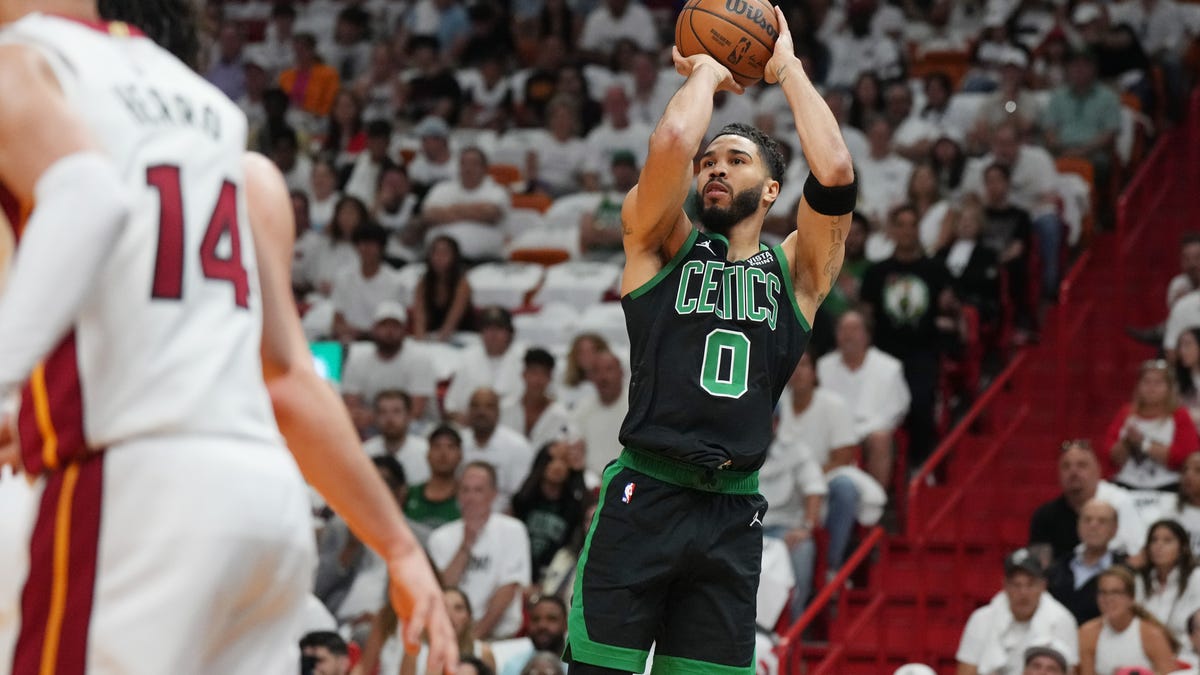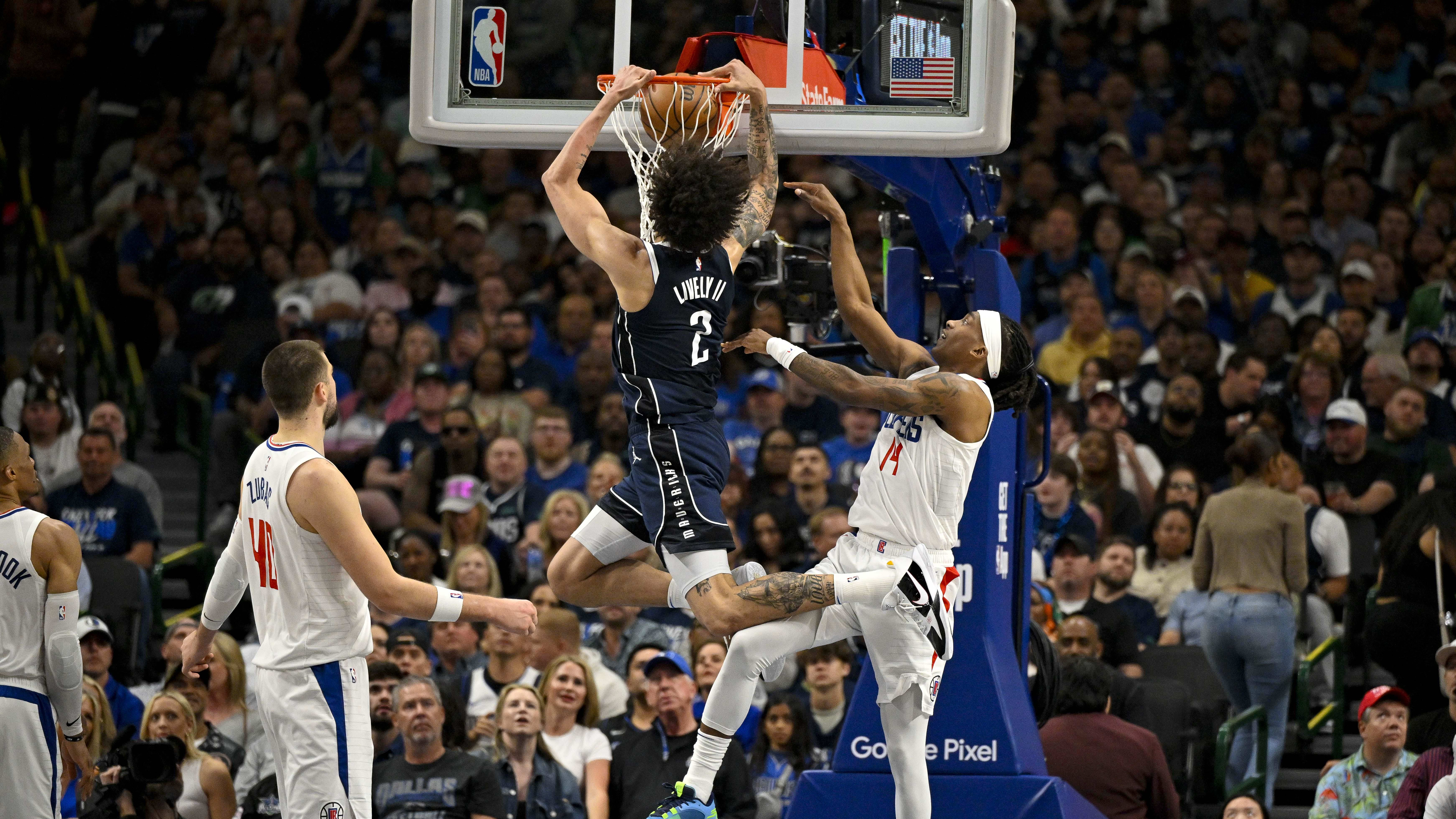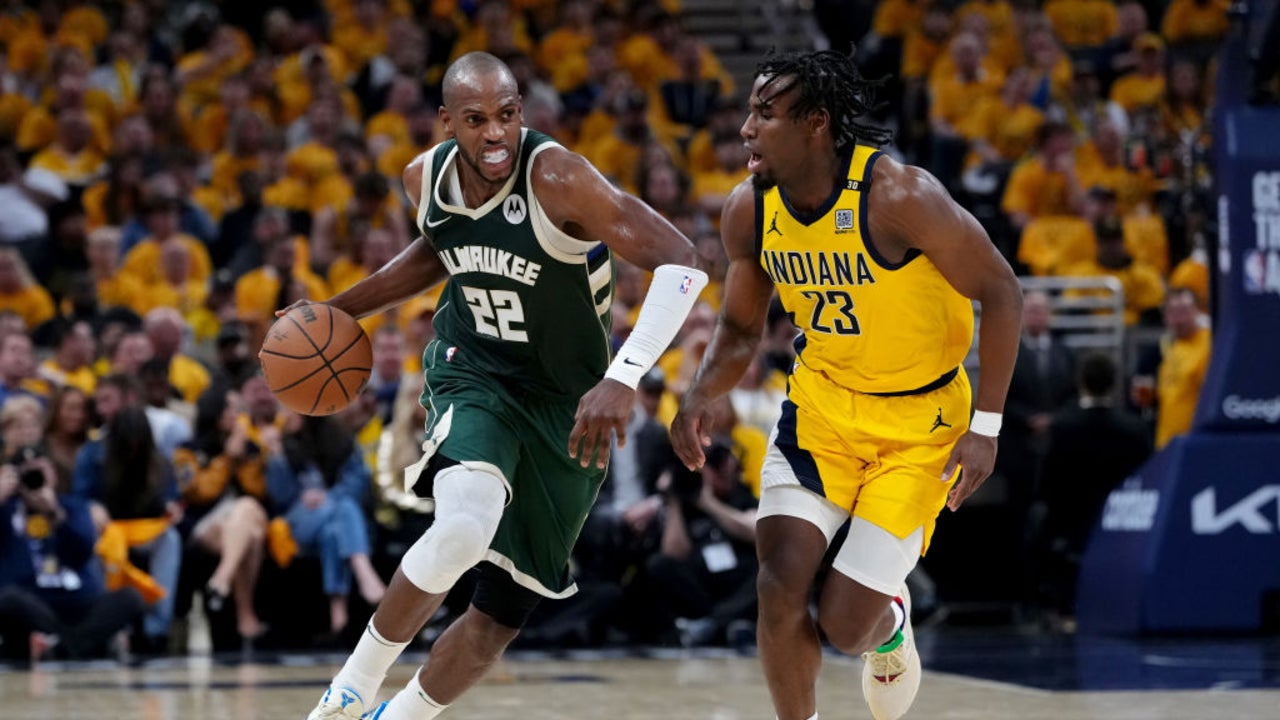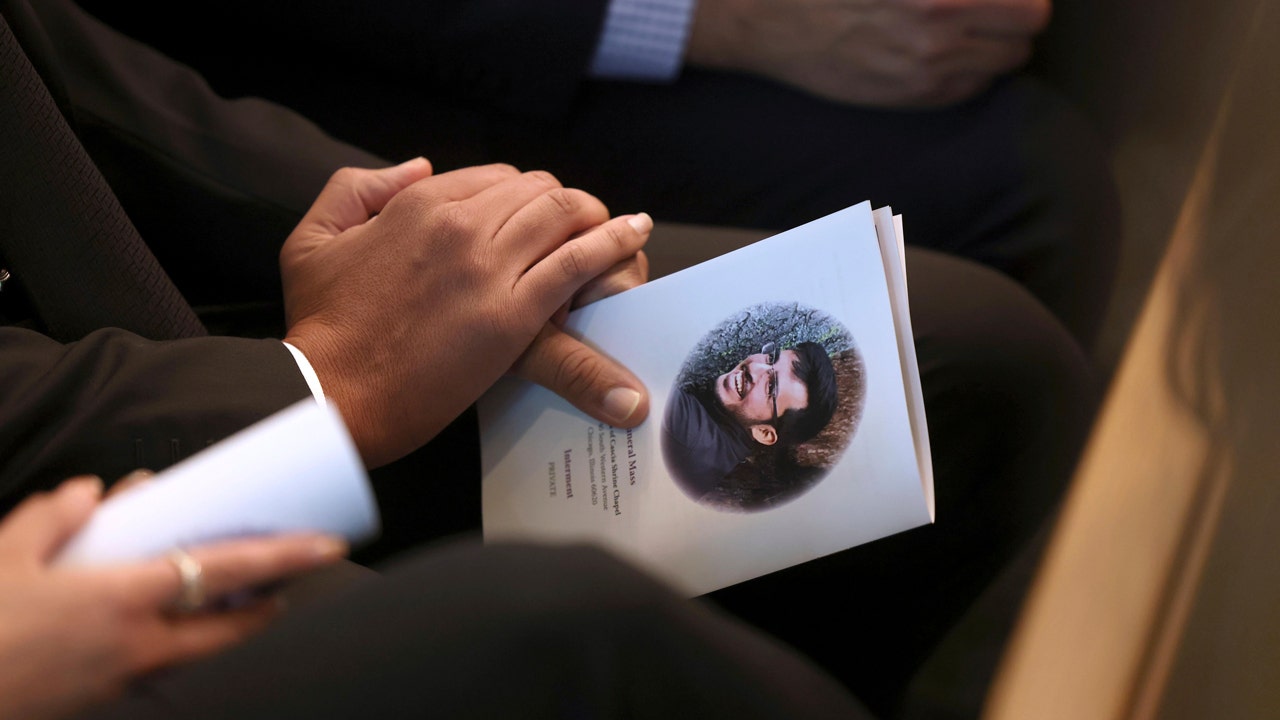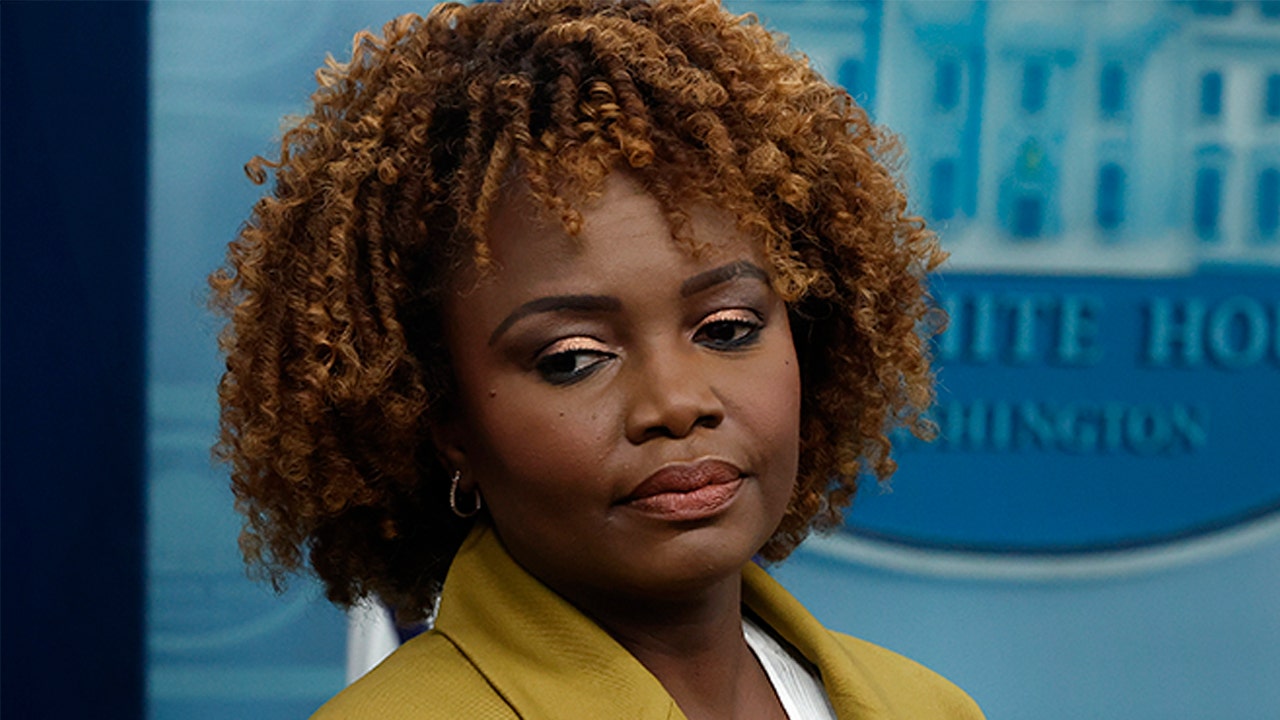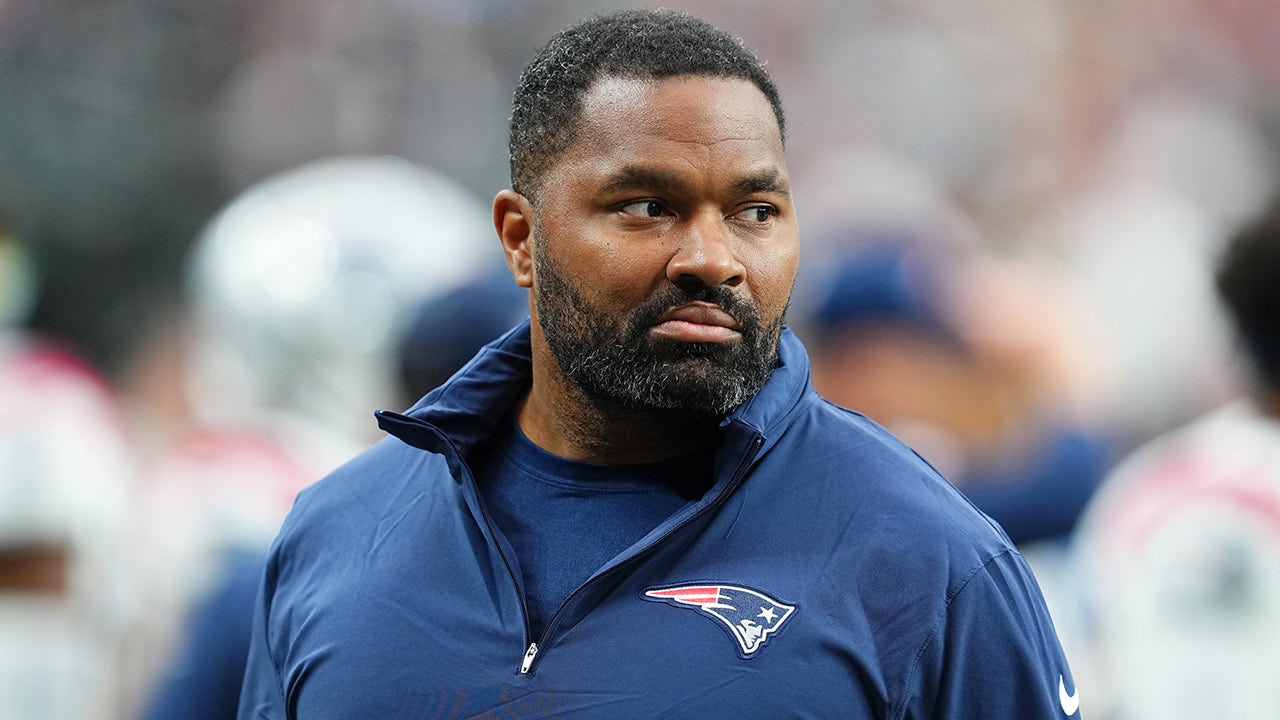Culture
Marjanović intentionally misses free throw, gets Clippers fans free chicken

The final day of the 2023-24 regular season saw several playoff teams jockeying for seeding, other teams trying to improve draft lottery odds and a few just hoping to end the campaign on a high note.
The Houston Rockets, who had made an unsuccessful late charge for the Play-In Tournament, fell into the latter category, looking for their first non-losing record since the 2019-20 season.
As it turned out Sunday, the Rockets and Los Angeles Clippers fans both took home a win.
With 4 minutes, 44 seconds remaining in the fourth quarter of Houston’s eventual 116-105 victory over the Clippers, center Boban Marjanović missed his first free throw. Marjanović — a career 76.4 percent free-throw shooter — then purposefully missed the second to win fans in attendance free chicken.
The Clippers organization runs a promo in which attending fans get free chicken if the opposition misses two consecutive free throws in the fourth quarter. So the Clippers faithful, who had seen its backups fight admirably all game, finally had something to cheer about, prompting the rising crescendo.
Boban.
Man of the people. 🍗 pic.twitter.com/PRq6xIXxIW
— NBA (@NBA) April 15, 2024
Rewarding home fans when two consecutive fourth-quarter free throws are missed has grown in popularity in recent years. In some blowouts when the end-of-bench players finally take the floor, some players miss the first free throw, getting the crowd riled up, only to make the second and mock them.
But if there was anyone in the NBA who would purposely miss to ensure that fans would go home with a reward, it would be Marjanović, who is arguably the nicest professional basketball player on the planet.
A finalist for this season’s NBA’s sportsmanship award, the former Clippers fan favorite has made a career of kindhearted gestures at his various stops around the league.
As soon as the second free throw rolled off the side of the rim, Marjanović raised one finger in the air, reminding the ongoers whom to thank for the free Chick-fil-A.
You can buy tickets to every NBA game here.
(Photo: Adam Pantozzi / Getty Images)

Culture
Anthony Edwards can't run from stardom anymore

PHOENIX — Fresh off, arguably, the most important performance of his young career, Anthony Edwards sat in front of the world with a white tank top and an all-black Atlanta Braves fitted cap that sat loose, hovering just above his crisp hairline — making him look more like an extra in Outkast’s “Player’s Ball” video than the future face of the NBA.
Edwards is who he is. Silly. Lovable. Intelligent. Country. He wears it all, loudly and proudly. He’s also a competitor. A trash-talker. He wears all of those things just as loud, just as proud.
You add all of that up and you have a star. You add all of those things up plus a 40-point performance in a playoff-sweeping 122-116 victory over the Phoenix Suns on Sunday night, and you start to enter superstardom.
Yet, Edwards, for one reason or another, is afraid to go there. For as honest, brash and confident as he is and can be, there lives a bashfulness inside the 22-year-old when it comes to talking about his stature within the sport’s most prestigious club.
A year ago, before a first-round loss to the eventual-champion Denver Nuggets, Edwards said he couldn’t consider himself a young star until he “wins in the playoffs.”
A year later, he did it. Edwards not only won in the playoffs, but he was the alpha in a series that featured the likes of Devin Booker and Kevin Durant, his all-time favorite player. Edwards led his organization to heights it hadn’t seen in 20 years, the second round of the NBA playoffs. He did it with rim-twisting dunks. He did it with a sweet shooting stroke. He did it with gnaw-your-arm-off defense. He did it with leadership. He did it with WWE “Suck It!” extracurriculars. He did it while giving an earful to the player he has looked up to since he was 5.
These are the things that make stars. This is what stardom looks like.
“Nah, not yet, man,” Edwards said Sunday after reaching the benchmark he placed on himself a year ago. “Not yet.”
Edwards, unbeknownst to him, lost the privilege to decide what he is and isn’t in this league.
Kevin Durant congratulates Anthony Edwards after Minnesota swept Phoenix in the first round of the NBA playoffs. (Christian Petersen / Getty Images)
When you score 40 points in a series-clinching victory — on the road at that — you’re a star. When you played 79 regular-season games and were the best player for a team that was one game short of having the top record in your conference, you’re a star. When you’re one of 12 players, at the age of 22, picked to represent your country in the Olympics, you’re a star. When you make everyone laugh every time you’re in front of a microphone, order McDonald’s off Uber Eats immediately after a game, like he did in Detroit last season, you’re a star.
“He’s the face of the league,” said teammate Karl-Anthony Towns, who sat next to Edwards as his reserved side took center stage when talking about his status in the NBA. “He hates when I say it, but it’s true. Like I said, ‘Future so bright, got to put the sunglasses on.’ ”
Regular players don’t decide to dominate when they have a chance to end their opponent for good. They don’t have that ability. Stars shoot 11 of 15 from the floor for 31 points in the second half when their team is trailing at halftime like Edwards did on Sunday. Stars muster up their last bit of energy late in the fourth quarter to throw down a “Night, night!” dunk — like he did with just over two minutes to play when he crossed up Bradley Beal on the wing, took a gather dribble, launched from outside of the paint and forced his childhood hero out of the way as he punished the rim like it hit his sister.
Stars get on their other star teammate amid all the chaos when they do something wrong like Edwards did when Towns committed another unnecessary foul with the game in the balance.
Edwards can’t run from it anymore. No matter how hard he tries. If he doesn’t want to be a star, then stop playing like one.
“He rises to the occasion,” Wolves forward Kyle Anderson told The Athletic.
Stars also make their teammates better. That’s the point of having a star. The gravity of one person makes the existence of others more meaningful.
Edwards picked apart the Suns’ defense as a playmaker. The 40 points will make the headlines, but he also had six assists with only two turnovers in 41 minutes of play. He should have had 10-plus assists, but the Wolves couldn’t buy a bucket in the game’s first 24 minutes.
There were signs throughout the season, but it was this series where Edwards blossomed as a creator for others. There were times early on in his career when it felt like he passed because he had to. There was nowhere else for him to go.
As the season went on, and this playoff series played out, Edwards was welcoming blitzes so that he could create advantages to make the pass to an open man, so that he could get his teammates involved in the flow of the game, so that this Timberwolves team could potentially do something only one team before has accomplished in the franchise’s 35-year history.
But, yeah, Edwards is not a star.
“He is a good person,” said Minnesota assistant coach Micah Nori, who filled in for coach Chris Finch after a collision on the sideline in the fourth quarter left him with a serious leg injury. “And what I mean by that is, they trust him. He’s got some self-humor. You’ve seen all of his interviews. He’s the first one to congratulate and move all of his glory over to his teammates. They all love him.
“When he plays, makes the right play, and they know he cares, not only about himself but the team, he’s done a good job of stepping up in that regard.”
Edwards can keep running from the label all he wants, but if he doesn’t want to embrace it out of fear of being content, then it will never go away. His mindset is correct. His intentions are good. But it’s impossible for anyone with two eyes and a pinch of sense not to see a star when they look at Edwards.
From this point on, there’s no point in even asking Edwards about it. He has spoken — with his play and his personality. He never needs to say it out loud. We’ll all keep saying it for him.
“He’s my favorite player to watch,” Durant said of his star pupil after Sunday’s game. “He’s just grown so much since coming in the league. At 22, his love for the game shines so bright. That’s one of the reasons why I like him the most because he just loves basketball and is grateful to be in this position.
“He’s going to be someone I follow for the rest of his career.”
Related reading
Krawczynski: Timberwolves fans deserve to celebrate a rare trip to Round 2
(Top photo: Ross D. Franklin / Associated Press)
Culture
NFL Draft 2024 Round 1 grades: Falcons, Broncos get Cs for Penix, Nix; Bears earn two A's

Welcome to The Athletic’s pick-by-pick grades for Round 1 of the 2024 NFL Draft. We broke down every selection as the drama unfolded throughout Thursday night. Which teams found the prospect (or prospects) they needed? Who might regret their decision down the line?
Of course, we won’t have full, accurate answers to those questions for a few seasons, so our grades tried to take everything into account — pick value, trade costs, what the board looked like at the time of the selection and so on.
Here’s how everyone did:
(Note: Scott Dochterman provided grades for odd-numbered picks, Nick Baumgardner for even-numbered picks.)
NFL Draft 2024 tracker: Live blog, pick-by-pick grades and analysis
Big board best available: Who’s left from Dane Brugler’s Top 300?
Full draft order: Team picks for all 257 selections
“The Athletic Football Show”: Watch live reaction to the draft
There was only one rational path for the Bears to take, and they took it. With the top pick and a shot at Williams in hand, the Bears practically gave away well-liked former first-rounder Justin Fields earlier this offseason. This selection is the right choice at the right time for a franchise that hasn’t had a starting Pro Bowl quarterback since Sid Luckman in 1942. In short order, Williams (6-foot-1, 214 pounds) could be just the third Pro Bowl QB overall for the Bears in the Super Bowl era.
The 2022 Heisman Trophy winner can lead in multiple ways and make every throw from any position, including on the run. He didn’t throw an interception on third or fourth down during his USC career and is seemingly in control in tight situations. He does need to work on fumbling issues (33 overall and 16 lost during his college career, counting his first season at Oklahoma).
Grade: A
GO DEEPER
NFL Draft 2024 ‘The Beast’ Guide: Dane Brugler’s scouting reports and player rankings
It’s a new day in Washington D.C., now complete with a new QB. The 2023 Heisman Trophy winner, Daniels threw for 57 touchdowns to just seven picks in two years with the Tigers. He was one of the most improved players in the country during that stretch, too. An electric dual-threat passer with elite speed and short-area quicks in space, Daniels is unique and built for the modern game.
Some had Daniels a bit behind Drake Maye, though Daniels was worthy of a top-five choice this year. He has to be better against pressure and show he can throw inside the numbers, but he’s a serious playmaker who knows how to lead and brings with him a terrific work ethic.
Grade: A
The Patriots had options to trade down and perhaps stockpile talent at other positions, but their need at quarterback was greater. It’s a risk for New England, which couldn’t turn Mac Jones into a success, but it’s the right one.
When one looks at Maye (6-4, 223), they can see a carbon copy of the prototypical quarterback. There’s no question he has every tangible quality NFL personnel seek at the position, and his intangible gifts are obvious, as well. But his career trajectory will tilt upward if he can slow down a bit and make all of the plays. That’s going to require patience from the Patriots’ front office, coaches and players — and from Maye himself.
Considering his potential, Maye may have the most upside of any quarterback in the draft. That’s worth betting on.
Grade: A
The Cardinals have more capital to work with in this draft than any other team, and GM Monti Ossenfort gets things started with a bang by adding a great new friend for Kyler Murray. Harrison is arguably the most complete receiver prospect we’ve seen in a decade, with no true holes in his game. His ability to adjust to off-target throws — deep and underneath — is unmatched in this class.
A trade down definitely could’ve made Arizona’s draft haul even greater, but the Cardinals needed a wide receiver. There’s nothing wrong with sticking and taking the best player at an area of need. Great pick, and possibly an elite one.
Grade: A
Jim Harbaugh built Michigan into a national champion by fortifying its offensive line. He now will attempt to do the same with the Chargers. Harbaugh had plenty of opportunities to trade down, but starting his tenure with an elite left tackle was too much to discard.
After beginning his career as a tight end, Alt slid to left tackle midway through his freshman year at Notre Dame and never vacated the position, making 33 consecutive starts. He has the requisite arm length (34 1/4 inches), quickness (1.73-second 10-yard split), strength and natural ability to play left tackle for a decade-plus in the NFL. His father, John Alt, was a stalwart left tackle with the Kansas City Chiefs in the 1980s and 1990s.
Grade: A-minus
Nabers is an electric playmaker and arguably this class’ most dangerous ball carrier in space. An incredibly smooth and explosive athlete with great ball skills, Nabers was an instant contributor in the SEC for LSU and made 161 catches (playing with Jayden Daniels) the last two seasons. There were some scouts who had Nabers ranked ahead of Harrison — he’s that good.
The Giants have questions about Daniel Jones, to be sure. But they still have so much work to do that bringing a first-round QB in to compete for the job wouldn’t have made much sense. Nabers is an awesome talent and will instantly make one of the slowest offenses faster. This is a sensible, efficient and potentially explosive draft pick.
Grade: A
Most receptions of 20+ yards over the last 5 years in CFB:
34 – Malik Nabers (2023), Ja’Marr Chase (2019)
33 – Jordan Addison (2021)
32
31
30 – DeVonta Smith (2020)
29
28
27
26 – Rome Odunze (2023), CeeDee Lamb (2019) pic.twitter.com/oGF9RR8ohY— Dane Brugler (@dpbrugler) December 1, 2023
Tennessee absolutely needed a tackle as part of its offensive line reconstruction, and Latham has the potential to become an anchor for a decade. But is this the right spot for him? He was a right tackle at Alabama, and the Titans have a glaring need at left tackle. If Latham can make that move, it’s perfect. If not, this becomes a question mark.
Perhaps the most powerful player in the draft, Latham caves in defenses when run blocking. He’s massive (6-5 1/2, 342) with an 85-inch wingspan and 35-inch arms. A second-team All-American last fall, Latham didn’t miss a game and made 27 consecutive starts at Alabama.
Grade: B
And we’ve found our first stunner. Months after signing Kirk Cousins to a four-year deal worth up to $180 million, the Falcons go quarterback — and not J.J. McCarthy. Instead, it’s Penix, the nearly 24-year-old lefty. This is beyond interesting and, for Cousins, perhaps feels like a bit of deja vu from his days alongside Robert Griffin III.
Penix is a talented passer, to be sure. But there are questions here: his age, his health (he’s had multiple leg injuries), his consistency as an accurate passer and the fact Cousins is making a fortune. Penix doesn’t throw the ball over the middle with nearly the same confidence he shows outside the numbers. He’s going to have to figure out better answers versus pressure.
But his arm talent is outstanding, and it’s hard to bet against his perseverance. At No. 8, though? This feels a reach. Time will tell.
Grade: C
The Falcons took Michael Penix Jr. with the No. 8 overall pick.
The crew reacts on The Athletic’s live Draft show: https://t.co/cHhKHwelvy pic.twitter.com/eI1PqP2Jbb
— The Athletic NFL (@TheAthleticNFL) April 26, 2024
9. Chicago Bears: Rome Odunze, WR, Washington
The Bears have remade their offense in two short years, and by selecting Odunze after getting Williams at No. 1, Chicago may have changed the trajectory of its franchise for perhaps the next decade. With Odunze, Keenan Allen and DJ Moore working with Williams, the Bears have a potentially explosive offense. (Yes, let that sink in.)
The FBS leader in receiving yards last year (1,640), Odunze (6-3, 212) has great size and length that eventually should lead to him playing X receiver. He’s fast and explosive (32 catches of 20-plus yards last year). With very good speed (4.45-second 40-yard dash) and a wide catch radius, Odunze can make big plays down the field in contested situations.
In most drafts, he’d be the top receiver chosen and among the favorites for Offensive Rookie of the Year.
Grade: A-plus
What an offseason for the Vikings. After making a big pre-draft move, Minnesota was able to land a quarterback (and climb one spot) without surrendering its other first-round pick. (The Vikings sent Nos. 11, 129 and 157 to the Jets for this spot and No. 203.) All this mere months after Minnesota lost Cousins, its previous franchise QB.
McCarthy’s skill set has had NFL evaluators on alert for three years, though his work inside Michigan’s run-heavy offense made it very difficult to totally project what he’ll be immediately in the NFL. A very tough, aggressive passer in the mold of his former coach (Harbaugh), McCarthy’s an unquestioned winner (63-3 record since high school).
He may need to learn behind Sam Darnold for a minute, but this is a great long-term fit with Kevin O’Connell — and he could be more ready early on than some believe.
Grade: A
11. New York Jets (from MIN): Olu Fashanu, OT, Penn State
In the debate between need and want, the Jets went with the latter, and in doing so laid a foundation for the future up front. Fashanu likely will get thrown in as a rookie and could become an anchor for the next decade. As tempting as tight end Brock Bowers had to be here, the Jets made the right move. Fashanu is a left tackle, and that’s important for the Jets’ future.
Massive and explosive, Fashanu was a force for the Penn State offensive line the last two seasons. He considered leaving for the NFL after the 2022 season but chose to return and became a consensus All-American, the Big Ten’s Offensive Lineman of the Year and a finalist for the Campbell Trophy (the “Academic Heisman”).
Grade: A
The 2024 quarterback thirst is very real. Make it six QBs gone in the top 12.
This one, somehow, didn’t feel as shocking as the Penix pick — in part because that already happened. There’s a lot to like about Nix. In fact, the conversation surrounding the former Oregon passer is very similar to the one about Penix: He’s older and comes with physical limitations. Unlike Penix, though, Nix played in a very college-style offense at Oregon.
But Sean Payton knows quarterbacks, and Denver can’t go anywhere without one. The fit here does work, as Nix’s quick release and poise should fit pretty well with Payton’s scheme. Still, as with the Penix pick, it sure feels like Denver could’ve gotten more value here. It’s a bold move, if nothing else.
Grade: C-plus
To justify this pick, you have to think of Bowers as a pass catcher, not strictly as a tight end. When you consider that his versatility will allow him to play alongside last year’s second-round tight end, Michael Mayer, then it could be a major coup. The Raiders will need to work heavily out of 12 personnel to make this fit. It’s a great value, but did Bowers fill a need?
That said, Bowers is a steal at this point. The first two-time Mackey Award winner as the nation’s top tight end, Bowers is a mismatch wherever he lines up — inline, slot, backfield or out wide. Few pass catchers find a way to get open like he does, and his 8.5 yards-after-catch average over his three seasons at Georgia is a rare number for his position. He was the best player on the field every time he stepped on it.
Grade: B-plus
The rush on quarterbacks really helped out a lot of teams in the back half of Round 1. It helped the Saints here, in a big way. Fuaga was a top-two tackle on some NFL boards, top-three on several more. And there wasn’t a team in the league more in need of tackle help than the Saints, who just landed a road grader.
Fuaga (6-5, 324) was dominant at times on the Beavers’ right side last season, as arguably the best run blocker in the country. This is a culture pick as much as anything else, too — Fuaga will help improve the team’s overall toughness up front. Great value for the Saints in the middle of the first round.
Grade: A
It took 15 picks, but Indianapolis finally selected this draft’s first defensive player. And the Colts got a good one in Latu, who might have been the best defensive player in college football last season (13.0 sacks, 21.5 tackles for loss). Indianapolis, meanwhile, ranked 28th in scoring defense, 24th in run defense and allowed 22 rushing touchdowns.
Latu should help in every area, and he’ll also entere the NFL as one of its best stories. His NFL dream nearly was derailed by a neck injury in 2020, which caused him to miss two seasons and led him to medically retire while at Washington; he was cleared to play again after surgery, then transferred to UCLA in 2022.
The only question is whether a cornerback might have been a more impactful pick, but Latu is a keeper.
Grade: B-plus

GO DEEPER
How star OLB Laiatu Latu masters the unique craft of pass rushing — and why
Good things come to those who wait? Sure, we’ll go with that. The Seahawks have had a need right in the middle of their defense for what seems like several years now. And after early runs on quarterbacks and tackles pushed the top defenders down, Seattle hit a whopper by landing the top interior defensive lineman in this draft.
Murphy, who can play nose or three-tech, is extremely powerful and explosive with a lethal punch at the point of attack. A smaller body in the Aaron Donald mold, Murphy is all gas off the line of scrimmage, and his natural leverage makes him a bear to deal with inside. Some teams valued him as a top-10 prospect in this draft. This is terrific value for new Seattle head coach Mike Macdonald.
Grade: A
17. Minnesota Vikings (from JAX): Dallas Turner, Edge, Alabama
After losing Danielle Hunter in free agency, the Vikings needed some pass-rush punch. So, Minnesota jumped up six spots (sending Nos. 23 and 167 plus third- and fourth-round picks in 2025 to Jacksonville) and grabbed perhaps the draft’s most athletic pass rusher. Turner was considered by many to be a possible top-10 pick. Edge was a need for the Vikings, too, probably equal to cornerback.
Turner (6-2, 247) was a consensus first-team All-American last season after posting 11.0 sacks, 15.5 tackles for loss and two forced fumbles. He solidified his first-round status with an impressive combine (4.46 40-yard dash, 40 1/2-inch vertical, 34 3/8-inch arms). He should replace Hunter quite nicely.
Grade: A
Mims might be the freakiest athlete in the entire draft. The 6-7, 340-pounder has 36 1/8-inch arms, a near 87-inch wingspan and 11 1/4-inch hands. He’s simply a massive human. He also runs like a tight end and can deliver a punch that will decleat anybody. His ceiling is more or less out of this world.
His floor, however? That’s another conversation. Mims started just eight games over three years at Georgia, missing six last year with an ankle injury. A right tackle only in college, Mims still makes a ton of youthful mistakes with his eyes and feet and will fall off blocks far too easily. However, with time in an NFL system and the right offensive line coach, he could develop into a true star.
Grade: B-plus
The Rams lost Aaron Donald, one of the greatest defensive linemen in NFL history, and needed to find some way to replace him. Verse likely won’t equal what Donald brought (nor would anyone else), but he was a nice choice for a team that hadn’t made a first-round pick since 2016. Chop Robinson might be more explosive with a higher upside, but Verse was more productive in college.
A workmanlike technician with a motor, Verse (6-4, 254) became an All-American after beginning his career at Albany as a no-star recruit. He played three seasons in the FCS (including one as a redshirt), then transferred to Florida State and posted back-to-back nine-sack seasons. Although he may not wow observers physically, Verse boasts one of this class’ top work ethics, which will serve him well in the NFL.
Grade: B
FSU’s Jared Verse just had the best two-game stretch of his career the last two weeks vs. Florida and Louisville. Dominated both games.
17 pressures, 6.0 TFL, 4.5 sacks, 1 FF pic.twitter.com/fu0hdyRCX9
— Dane Brugler (@dpbrugler) December 3, 2023
One of the most versatile linemen in this draft, Fautanu is bit oddly shaped for his position — in a good way. At 6-3, 317, Fautanu plays low to the ground but also has great length (34 1/2-inch arms). A left tackle at Washington, Fautanu is athletic and a possible five-position prospect. The Steelers announced him as a tackle, but he also could play guard and maybe even center.
The Steelers need help in the middle of their offensive line, so it won’t be a shock if he gets a shot there. If that doesn’t work out, though, he could play opposite Broderick Jones or inside at guard. This is a great pick and an outstanding value.
Grade: A
With both of its starting edge rushers (Jaelan Phillips and Bradley Chubb) coming back from season-ending injuries, Miami needed reinforcements, even if just to rotate. The Dolphins picked up perhaps the best player available, and one with plenty of upside. They could have used an offensive lineman, but an earlier run at that position helped nudge them toward Robinson.
One of the most feared pass rushers in the Big Ten, Robinson commanded attention last year on Penn State’s elite defense. He picked up just four sacks and 7.5 tackles for loss in 10 games, but he was regularly double teamed in passing situations. The 6-3, 254-pounder has elite get-off at the line of scrimmage, which was validated by his 4.48 40 at the combine.
Grade: B-plus
Many wondered if Philadelphia might move up to address its obvious need at corner. Instead, with six quarterbacks going in the top 12, the corners fell to the Eagles.
One of the humblest players in the draft, Mitchell turned down big NIL money offered by SEC schools to stay at Toledo and finish his degree. As a player, he’s big, long and extremely fast — Mitchell burned a 4.33 at the combine, posted a 38-inch vertical and a broad jump of 10 feet, 2 inches, and was downright dominant at the Senior Bowl. He improved every day at Toledo and wound up with a whopping 52 passes defended over three years.
For Philadelphia, this couldn’t have gone better.
Grade: A

GO DEEPER
NFL Draft’s quiet star was built for this moment — and he’s rising up draft boards
After losing receiver Calvin Ridley in free agency, the Jaguars needed a replacement who could stretch the field and develop into a No. 1 option for quarterback Trevor Lawrence. Thomas might cover both needs. He’s got tremendous athletic ability and is capable of catching double-digit touchdown passes as a rookie.
At LSU, playing alongside Nabers, Thomas (6-3, 209) was a third-team All-American and led the country in touchdown catches (17) last season, while posting 68 receptions for 1,177 yards (17.3 yards per catch). At the combine, he ran a 4.33 40, the second-fastest time among all receivers.
Grade: A-minus
The hometown fans were concerned that the Lions might trade out of the first round. But as the corners started falling Thursday night, GM Brad Holmes couldn’t help but pick up the phone. Detroit moved up five spots (sending Nos. 29 and 73 to Dallas for No. 24 and a 2025 seventh-round pick) and filled a big need.
Like the Eagles, the Lions landed outstanding value in the 20s — Arnold and Mitchell were pretty clearly the top two corners in this draft. For Detroit, this was also a perfect fit for the team’s established culture. Arnold is a confident corner who plays with swagger, loves to work, loves tough coaching and loves to win. Arnold will reunite with former Alabama teammate Brian Branch in a new-look Detroit secondary. Another great value pick.
Grade: A
The Packers had needs both along their offensive line and in the secondary. They opted for Morgan rather than addressing that secondary, which intercepted a league-low seven passes last season. Morgan certainly is a first-round prospect, but Green Bay missed a chance to improve at its most vulnerable spot.
Largely considered a guard, Morgan (6-5, 311) started 37 games over five seasons at Arizona. His arm length (32 7/8 inches) probably will keep him inside, but he could kick outside, if necessary. He should be able to start right away at right guard.
Grade: C
Up there with Fautanu among the most versatile linemen in this class, Barton gained college starting experience at both center and tackle. He’ll most likely get a shot inside with the Buccaneers, who announced him as a center (and are in need of a center) but also could use a boost at guard.
One of the most powerful linemen in the class, Barton doesn’t have ideal length to play outside in the NFL. His power and IQ (along with his feet) are more than enough to be terrific inside, though.. He’s probably an interior-only lineman in the NFL, but he has a chance to be very good for a long time.
Grade: A-minus
27. Arizona Cardinals: Darius Robinson, Edge, Missouri
The Cardinals ranked last in run defense, 31st in scoring defense and allowed 4.7 yards per carry last season. They needed a talent infusion along their defensive line, and Robinson should provide it, likely as a 3-4 defensive end.
The best word to describe Robinson is “massive.” With a frame that could lead him to an edge or interior role, Robinson (6-5, 285) has positional flexibility up and down the line. He also boasts an extraordinary wingspan (84 3/8 inches) and incredible hand size (10 5/8 inches). At Missouri, Robinson was productive (8.5 sacks and 14 tackles for loss) and earned first-team All-SEC honors. He also was considered the leader on a team that beat Ohio State in the Cotton Bowl, and he was voted the practice player of the week at the Senior Bowl.
Grade: A-minus
Welcome to the Darius Robinson show.
Efficient arm-over vs. Tyler Guyton. pic.twitter.com/KM3VMUEDVJ
— Dane Brugler (@dpbrugler) January 31, 2024
28. Kansas City Chiefs (from BUF): Xavier Worthy, WR, Texas
Patrick Mahomes has yet to meet a player he can overthrow. We’ll see if Worthy gives him a run for his money.
The Chiefs moved up from the end of Round 1 — sending picks 32, 95 and 221 to Buffalo for Nos. 28, 133 and 248 — and snagged the fastest player in this draft. (Worthy set the combine record with a 4.21-second 40 earlier this spring.) This feels like a very good fit for Kansas City’s offense, and for Mahomes in particular, as Worthy is dynamic with the ball in his hands.
However, he’s also very small, at just 165 pounds. Whether or not he’ll be able to hold up with a high catch volume deep into a season is a fair question. Worthy can be inconsistent with his hands, too, and his play strength will limit some of what he can do a the next level. Was he a first-round prospect in this draft, especially with some of the talent still on the board? Maybe. But it’s tough to hate the fit.
Grade: B
“If he hits, he’s DeSean Jackson. But that’s a big if.”@dpbrugler on Patrick Mahomes’ newest weapon Xavier Worthy 👀https://t.co/cHhKHwelvy pic.twitter.com/I6zjfitmp7
— The Athletic NFL (@TheAthleticNFL) April 26, 2024
Dallas had big holes at two spots, center and right tackle, and filled the one on the outside here. It’s an upside move, as Guyton could start at right tackle and perhaps flip to left tackle in time. If he reaches his potential, he could form a solid tandem with Tyler Smith.
Still raw and developing, Guyton started 14 games at Oklahoma — 13 at right tackle, one at left tackle — before declaring for the draft. He also started one game as a tight end at TCU in 2021. Guyton (6-7 1/2, 322) has the requisite body for an NFL tackle (34 1/8-inch arms). It might take him some time, but his upside is immense.
Grade: B
One of the fastest players on the board (4.28 40 at the combine), Wiggins is quick off the line of scrimmage and also possesses excellent second-level speed — a combination that makes him incredibly difficult to beat vertically. Wiggins’ length (6-1 with almost 31-inch arms) is also a plus. He got his hands on a combined 25 passes over the last two seasons at Clemson.
The question marks here are size and power. Wiggins weighed 173 pounds at the combine, before checking in at a reported 182 pounds at his pro day. He was mainly an outside-only corner in college, and it remains to be seen how much he can give the Ravens against the run. He’s a first-round talent in this draft, though, to be sure.
Grade: A-minus
This feels like either a reach or an insurance policy, in case Brandon Aiyuk ends up getting dealt. Pearsall will make some tough catches and could wind up running plenty of interior routes alongside tight end George Kittle.
A five-year veteran who spent three seasons at Arizona State and two at Florida, Pearsall (6-1, 189) built a reputation for his toughness and ability to haul in difficult catches. Last year with the Gators, Pearsall caught 65 balls for 965 yards (14.8 yards per catch) and four scores. As a junior, Pearsall averaged 20.0 yards per catch (33-661) with five scores. He also ran a 4.41 40 at the combine and had a 42-inch vertical jump.
Grade: B-minus
The Panthers moved up one spot (picks 33 and 141 to Buffalo for Nos. 32 and 200) to snag help for QB Bryce Young. A 6-1, 221-pounder with a 40-inch vertical, Legette is a powerful blend of speed (4.39 40) and explosion. He looks and runs a lot like Seattle star DK Metcalf.
There are concerns, however. Before his breakout 2023 season (71 catches for 1,255 yards and seven touchdowns), Legette had a combined 42 receptions over his previous four years. He’s also 23 years old and not yet a consistent route runner. But he is a credible deep threat who will provide help as a returner. Would Texas’ Adonai Mitchell or Georgia’s Ladd McConkey have been a better option here?
Grade: C-plus
(Illustration: Eamonn Dalton / The Athletic; Photo of Michael Penix Jr.: CFP / Getty Images)
Culture
Cousins stunned Falcons drafted Penix Jr. in first round

The Atlanta Falcons made a surprising selection taking former Washington quarterback Michael Penix Jr. with the No. 8 pick in the 2024 NFL Draft.
Among those shocked by the selection was their current projected starting quarterback, Kirk Cousins.
The Falcons called Cousins when they were on the clock to let him know they were taking Penix, his agent, Mike McCartney, told The Athletic. When Cousins signed with the team this offseason, the Falcons told him they would be drafting a quarterback in the later rounds of this draft. He was stunned when they took one in the first round, and Cousins’ biggest concern is that the pick doesn’t help the team for the upcoming season.
Part of the reason Atlanta selected Penix is that it believes it won’t have a top pick in coming drafts with Cousins under center the next few years, a team source told The Athletic.
The Falcons signed Cousins this offseason to a four-year deal worth $180 million, including $100 million guaranteed. The 35-year-old quarterback is recovering from the torn Achilles tendon he sustained in Week 8 last season. Cousins said at his introductory news conference in March that he could take drops and make passes, but if added, “I think the minute I would have to leave the pocket is where you’d say, ‘Yeah, he’s still recovering from an Achilles.’”
Opinions varied on Penix
I didn’t think the Falcons would use the eighth pick for Penix, that’s for sure, but I do think Penix was a really interesting prospect in this draft.
Two former head coaches with strong track records were among the people I spoke with during the draft process who had Penix as their No. 2 quarterback in this draft, behind Caleb Williams. It seemed like very few people agreed with this assessment.
My feel during Super Bowl week was that Penix would be gone by the middle of the first round, but the recent chatter surrounding him made me feel like that was a stretch. With quarterbacks, there can be great volatility. If a team loves one, the team should take him. And when teams feel set at the position already, they simply do not select them most of the time. That is how someone like Penix can go earlier than expected while an Aaron Rodgers waits longer than expected. — Mike Sando, National NFL writer
Required reading
(Photo: Jorge Lemus / NurPhoto via Getty Images)
-

 News1 week ago
News1 week agoIs this fictitious civil war closer to reality than we think? : Consider This from NPR
-

 World1 week ago
World1 week agoShipping firms plead for UN help amid escalating Middle East conflict
-

 Politics1 week ago
Politics1 week agoICE chief says this foreign adversary isn’t taking back its illegal immigrants
-

 Politics1 week ago
Politics1 week ago'Nothing more backwards' than US funding Ukraine border security but not our own, conservatives say
-

 News1 week ago
News1 week agoThe San Francisco Zoo will receive a pair of pandas from China
-

 World1 week ago
World1 week agoTwo Mexican mayoral contenders found dead on same day
-

 Politics1 week ago
Politics1 week agoRepublican aims to break decades long Senate election losing streak in this blue state
-

 World1 week ago
World1 week agoBrussels, my love? The EU single market is not sexy enough for voters

